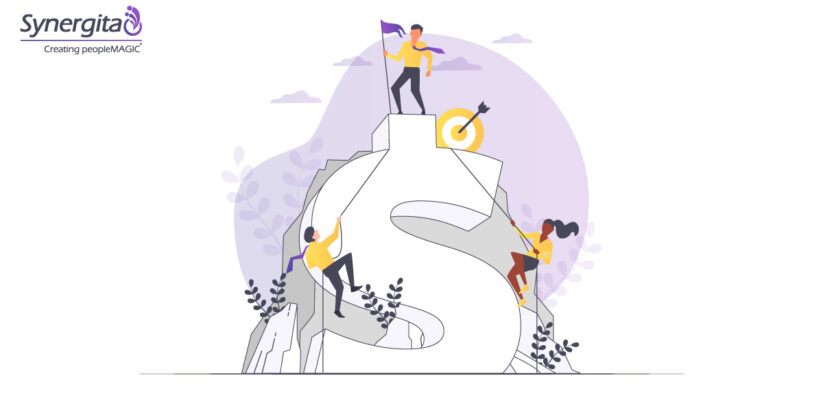10 Ways to Leverage OKRs and Stretch Goals for Continuous Improvement
There are numerous organizations across the globe that continually evolve, develop, and achieve their desired outcomes. However, in today’s fast-paced business environment, businesses must continuously improve to stay ahead of the competition.
Achieving this requires companies to set goals and objectives that align with their vision and mission. OKRs and stretch goals can help companies improve their performance. In this blog, we will explore how organizations can use OKRs and stretch goals to drive continuous improvement. However, it is essential to understand what OKRs and stretch goals are.
What is an OKR?
- OKR stands for Objectives and Key Results, a goal-setting framework that helps organizations align their goals and focus on achieving measurable results.
- An objective is a goal that an organization wants to achieve, and key results are measurable steps that help track progress towards that goal.
- OKRs are typically set on a quarterly basis, but they can also be set annually or even monthly.
- OKRs are meant to be ambitious and challenging, but also realistic and achievable.
What are Stretch Goals?
- Stretch goals are goals that are significantly more ambitious than what an organization typically aims for.
- They push individuals or organizations to go beyond their usual limits and strive for exceptional performance.
- Stretch goals are meant to be challenging but achievable and can motivate individuals and teams to think creatively and work harder.
Benefits of Using OKRs and Stretch Goals for Continuous Improvement
- Clarity and focus: OKR and stretch goals can provide clarity, focus, and alignment towards common goals for your team and organization. This can help align everyone in the organization to a common purpose.
- Improved accountability: Setting clear goals and stretch targets allows for better tracking of progress and identifying areas for improvement, leading to increased accountability and optimized performance and making it easier to identify the areas that need improvement.
- Promoting innovation: Setting stretch goals can make teams and individuals think outside the box and come up with different and better solutions for any problem. This encourages them to refrain from the mundane ways of approaching any issue.
- Enhanced motivation and engagement: OKRs provide clarity to teams and individuals, which can instigate motivation and increase the quality of work. Additionally, setting stretch goals can increase employee engagement, as they will have something new to strive for.
- Increased transparency and communication: OKRs and stretch goals can promote transparency and effective communication between team members, departments, and leaders.

All these factors can lead to better team collaboration and coordination which ultimately aids in breaking the silos and paving the way to better organizational culture. It fosters continuous learning and development.
Define and Align your Objectives and Key Results (OKRs):
Objectives and Key Results are a popular and proven goal framework adopted by many corporates for setting goals and measuring the progress towards achieving them.
Some possible ways of defining and aligning your objectives and key results are listed below:
1. Define your objectives:
- Start by setting a clear, specific, and measurable objective that aligns with your overall vision and mission.
- Make sure your objective is ambitious yet achievable, relevant to your stakeholders, and time bound.
- Ensure your objective is inspiring and motivating for your team.
2. Define your key results:
- Identify the specific outcomes that will demonstrate progress towards achieving your objective.
- Make sure your key results are measurable, specific, and time-bound.
- Ensure your key results are challenging yet realistic and that they align with your overall objective.
- Set a few key results for each objective to avoid overwhelming your team.
3. Align your objectives and key results
- Ensure your objectives and key results are aligned with your organization’s overall strategy and mission.
- Communicate your objectives and key results clearly to your team and stakeholders.
- Set up regular check-ins to monitor progress towards achieving your objectives and key results.
- Adjust your objectives and key results as needed based on progress and changes in your organization’s strategy.
By following these steps to define and align your objectives and key results, you can ensure that your team is focused, motivated, and working towards achieving your organization’s vision and mission.

How to Establish Stretch Goals?
Ways to Leverage OKRs and Stretch Goals for Continuous Improvement
Following are the ten ways to leverage OKRs and stretch goals for continuous improvement:
- Align OKRs and Stretch Goals with the Organization’s Vision: Ensure that the OKRs and stretch goals align with the company’s long-term vision. This will help to provide direction and focus for the team and ensure that everyone is working towards the same goal.
- Use Stretch Goals to Challenge the Team: Stretch goals should be ambitious and should challenge the team to go above and beyond what they thought was possible. This will help to create a culture of continuous improvement where the team is always striving to do better.
- Break Down OKRs and Stretch Goals into Smaller Objectives: Break down the OKRs and stretch goals into smaller, more manageable objectives. This will help the team to stay focused on the task at hand and make progress towards the larger goal.
- Set Clear Metrics for Measuring Success: Set clear metrics for measuring success and track progress regularly. This will help to identify areas where the team is doing well and areas that need improvement.
- Encourage Collaboration and Communication: Encourage collaboration and communication between team members to ensure that everyone is on the same page. This will help to identify issues early on and find solutions quickly.
- Provide Resources and Support: Provide the team with the resources and support they need to achieve their OKRs and stretch goals. This could include additional training, equipment, or personnel.
- Celebrate Milestones and Achievements: Celebrate milestones and achievements along the way to keep the team motivated and focused. This will help to build momentum and keep everyone working towards the larger goal.
- Evaluate Results and Adjust as Needed: Evaluate the results of the OKRs and stretch goals regularly and adjust as needed. This will help to ensure that the team is making progress towards the larger goal and identify areas that need improvement.
- Incorporate Feedback: Incorporate feedback from team members and stakeholders to make improvements and refine the OKRs and stretch goals. This will help to ensure that everyone is on board and committed to the process.
- Make Continuous Improvement a Part of the Culture: Make continuous improvement a part of the company culture by regularly revisiting the OKRs and stretch goals and encouraging everyone to strive for excellence. This will help to create a culture of learning and growth where everyone is working together towards a common goal.
Apart from the above ways, creating a culture of accountability, providing opportunities for continuous learning and development, and using data-driven insights to refine your strategies can also be some of the additional ways to leverage OKRs and stretch goals for continuous improvement.
Final Thoughts
Incorporating OKRs and stretch goals into an organization’s performance management and goal-setting processes can yield numerous benefits, including improved accountability, increased performance, and a culture of innovation and learning. By leveraging these powerful tools, organizations can create a framework for setting ambitious targets, foster a culture of accountability, and use data-driven insights to drive continuous improvement.
Going in line with what Tony Robbins said, “Setting goals is the first step in turning the invisible into the visible”, leave no stone unturned by implementing OKRs and stretch goals in your organizations for continuous improvement and increased performance. In conclusion, it is very important for leaders to embrace the power of OKRs and stretch goals and pave the way for their employees as well as organization’s success.
| Related Articles | |
|---|---|
| 12 Reasons Why OKRs Work It is a proven practice adopted by the world’s leading organizations, and its popularity is gaining ground as businesses of all sizes across different industries find OKRs the most effective in setting and meeting Read More. | The Ultimate OKR Rollout Checklist For 2023 From planning to implementation, you’ll find all the trivial information on OKR that helps you successfully manage the Read More. |
How Adopting OKRs Helps Create Organization Wide Alignment As a business owner, you have a vision and have devised a mission to accomplish your objectives. You have hired the top performers from the Read More. | How To Create A Complete OKR Checklist As you know, market competition is at an all-time high. With the transformation of the business environment and the rise of Read More. |
